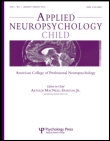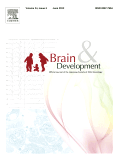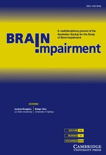
Journal of Pediatric Neuropsychology
Scope & Guideline
Innovating practices for neuropsychological health in youth.
Introduction
Aims and Scopes
- Pediatric Neuropsychological Assessment:
The journal prioritizes studies that explore methods and tools for assessing neuropsychological functions in children, including the validity and reliability of various assessment instruments. - Impact of Neurological Disorders on Development:
Research published in this journal often examines how neurological and neurodevelopmental disorders, such as ADHD, epilepsy, and dyslexia, influence cognitive and behavioral development in children. - Multidisciplinary Approaches to Neuropsychology:
The journal encourages interdisciplinary research that integrates findings from psychology, neuroscience, education, and medicine to provide a comprehensive view of pediatric neuropsychology. - Cultural and Socioeconomic Influences:
It also emphasizes the importance of understanding cultural and socioeconomic factors in neuropsychological outcomes and assessments, ensuring research is relevant to diverse populations. - Innovative Therapeutic Interventions:
The journal highlights innovative therapeutic interventions and emerging technologies, such as virtual reality and mobile applications, aimed at improving cognitive and behavioral outcomes in pediatric patients.
Trending and Emerging
- Impact of COVID-19 on Pediatric Populations:
There is a growing body of research focused on the effects of the COVID-19 pandemic on children's mental health, neurodevelopment, and educational outcomes, highlighting the need for adaptive strategies in response to this global crisis. - Screen Time and Digital Health:
Studies examining the relationship between screen time, emotional and behavioral functioning, and cognitive outcomes are trending, reflecting the increasing relevance of digital environments in children's lives. - Neuroimaging and Neuropsychological Integration:
Research exploring the integration of neuroimaging findings into neuropsychological assessment and interpretation is emerging, indicating a trend towards utilizing advanced technologies to inform clinical practices. - Cultural Competence in Assessments:
There is an increasing emphasis on understanding cultural and contextual factors in neuropsychological assessments, aiming to reduce biases and improve the applicability of findings across diverse populations. - Innovative Therapeutic Approaches:
The exploration of novel therapeutic interventions, particularly those leveraging technology and virtual reality, is gaining traction, reflecting a shift towards more engaging and effective treatment modalities for children.
Declining or Waning
- Traditional Assessment Methods:
There has been a noticeable decline in studies focusing on traditional neuropsychological assessment methods, possibly due to the increasing adoption of innovative, technology-driven approaches. - Generalized Studies on Common Disorders:
Research that broadly addresses common pediatric disorders without specific neuropsychological implications is less frequent, indicating a shift towards more specialized and nuanced investigations. - Legal and Ethical Discussions:
Themes related to legal implications of neuropsychological findings, particularly in juvenile justice, have diminished, suggesting a reduced focus on the intersection of law and neuropsychology.
Similar Journals

NEUROPSYCHOLOGICAL REHABILITATION
Advancing the Science of Cognitive RecoveryNEUROPSYCHOLOGICAL REHABILITATION is a prestigious peer-reviewed journal dedicated to the field of neuropsychology and rehabilitation. Published by Routledge Journals, Taylor & Francis Ltd, it stands at the forefront of research and development in applied psychology, arts and humanities, and rehabilitation, boasting an impressive impact factor and a distinguished ranking within various academic categories. With a strong commitment to advancing the science of rehabilitation and cognitive recovery, the journal aims to provide a platform for innovative research, systematic reviews, and clinical findings that inform best practices in the field. As it converges into its third decade of publication—from 1991 to 2024—NEUROPSYCHOLOGICAL REHABILITATION remains essential for researchers, clinicians, and students seeking cutting-edge insights and methodologies to enhance patient care and cognitive rehabilitation strategies.

Applied Neuropsychology-Child
Fostering interdisciplinary dialogue for child development.Applied Neuropsychology-Child is a leading academic journal dedicated to advancing the field of developmental and educational psychology, as well as neuropsychology, with a particular focus on child development. Published by Routledge Journals, Taylor & Francis Ltd, this journal provides critical insights into the cognitive and behavioral aspects of children, fostering interdisciplinary dialogue among researchers, clinicians, and educators. With a commendable impact factor and a categorization of Q3 in both associated fields for 2023, the journal plays a pivotal role in shaping current practices and enhancing academic discourse. Access to Applied Neuropsychology-Child is available through subscription, ensuring that high-quality research is disseminated widely amongst scholars and professionals. Since its inception in 2012, this journal has consistently aimed to illuminate the challenges and developments in child neuropsychology, making it an essential resource for anyone invested in the psychological well-being and educational success of children.

BRAIN & DEVELOPMENT
Advancing the Frontiers of Pediatric NeuroscienceBRAIN & DEVELOPMENT is a prestigious academic journal published by ELSEVIER, renowned for its pivotal contributions to the fields of developmental neuroscience, neurology, and pediatrics. Established in 1979, this journal has become an essential resource for researchers and clinicians alike, as it explores the complexities of brain development and associated neurological disorders in children. With an impactful focus on advancing scientific understanding, BRAIN & DEVELOPMENT is currently ranked in the Q3 quartile in Developmental Neuroscience and Clinical Neurology and Q2 in Pediatrics, reflecting its significance within the medical community. Its ISSN 0387-7604 and E-ISSN 1872-7131 underline its established presence in academic literature. While the journal does not offer open access options, it continues to be a key platform for disseminating new research findings and fostering innovation in the understanding of pediatric neurological health. The journal's commitment to quality research is further evidenced by its ongoing publication trajectory up until 2024, making it a vital source of knowledge for students, professionals, and educators in related fields.

NEUROPSYCHOLOGY REVIEW
Illuminating the Links Between Neural Mechanisms and BehaviorNEUROPSYCHOLOGY REVIEW is a prestigious journal published by Springer, dedicated to the exploration of cognitive processes and behavior through neurological and psychological perspectives. With its ISSN 1040-7308 and E-ISSN 1573-6660, this journal holds a distinguished position in Q1 of the Neuropsychology and Physiological Psychology category, ranking at #3 out of 76 with an impressive 96th percentile in Scopus. Since its inception in 1990, it has provided a critical platform for researchers, professionals, and students to disseminate and engage with comprehensive reviews and empirical research, promoting a deeper understanding of the interplay between neural mechanisms and psychological phenomena. Aimed at fostering interdisciplinary collaboration and advancement in the field, NEUROPSYCHOLOGY REVIEW invites contributions that push the boundaries of knowledge and stimulate ongoing debates in neuropsychology, making it an invaluable resource for anyone interested in the latest scientific advancements within this dynamic area.

NEUROPEDIATRICS
Exploring the frontiers of children's neurological health.NEUROPEDIATRICS is a prominent academic journal published by GEORG THIEME VERLAG KG, dedicated to advancing the understanding and treatment of neurological disorders in children. Established in 1980, this journal has consistently provided a platform for innovative research and clinical practice in the fields of pediatrics and neurology, culminating in its recognition across various rankings; it holds a Q2 rating in Pediatrics, Perinatology and Child Health, and Q3 in both Medicine (miscellaneous) and Neurology (clinical) as of 2023. While NEUROPEDIATRICS is not an open access journal, it remains a crucial resource for researchers, clinicians, and students who seek cutting-edge insights and evidence-based practices in the management of pediatric neurological issues. As a result, NEUROPEDIATRICS plays an indispensable role in shaping future research directions and improving health outcomes in this vital field.

NEUROPSYCHOLOGY
Celebrating Over Three Decades of Neuropsychological ExcellenceNEUROPSYCHOLOGY, published by the American Psychological Association, is a leading journal dedicated to advancing the field of neuropsychology and physiological psychology. With an ISSN of 0894-4105 and an E-ISSN of 1931-1559, the journal has established itself as a critical resource for researchers, clinicians, and students interested in the intersection of neuroscience and psychological practice. Recognized as a Q1 journal in its category for 2023, it holds a prominent position within the top quartile of neuropsychology journals, reflecting its rigorous peer-review process and high-quality publications. Covering a wide spectrum of topics from cognitive functions and brain-behavior relationships to clinical assessments and interventions, NEUROPSYCHOLOGY plays a pivotal role in disseminating significant research findings that enhance our understanding of the brain's complexities. Although this journal does not currently offer Open Access, it remains highly regarded for its contribution to the scientific community, as evidenced by its strong Scopus ranking of #34/76 in neuropsychology. As it marks over three decades of publication from 1990 to 2024, NEUROPSYCHOLOGY continues to be an essential publication for those committed to exploring and improving the field.

NEUROPSYCHOBIOLOGY
Innovative Insights: Unraveling the Complexities of Mind and BrainNEUROPSYCHOBIOLOGY, published by KARGER, is a leading academic journal that has been at the forefront of exploring the intricate relationships between neuroscience and psychological processes since its inception in 1975. With both an ISSN of 0302-282X and an E-ISSN of 1423-0224, the journal is renowned for its rigorous peer-reviewed articles and significant contributions to the fields of Biological Psychiatry, Neuropsychology, and Physiological Psychology. Its impact is reflected in its esteemed Scopus rankings, standing out in the 92nd and 81st percentiles in their respective categories. With a commitment to advancing understanding in mental health and neurological science, NEUROPSYCHOBIOLOGY is classified in the Q3 and Q1 quartiles, making it a vital resource for researchers, clinicians, and students alike. Based in Switzerland, the journal embraces a holistic approach to psychological research, bridging gaps between theoretical frameworks and practical applications, thus promoting impactful advancements in the understanding of the human mind.
Explore the latest findings and theories with NEUROPSYCHOBIOLOGY, where your work can contribute to the evolving landscape of neuropsychological studies.

Brain Impairment
Bridging research and application in cognitive health.Brain Impairment, published by Cambridge University Press, is a pivotal academic journal dedicated to advancing the understanding of neurological conditions and cognitive processes. With its ISSN 1443-9646 and E-ISSN 1839-5252, this esteemed journal has been at the forefront of research in the fields of Behavioral Neuroscience, Cognitive Neuroscience, and Neuropsychology since its inception in 2004. Covering a broad scope, it addresses critical insights into brain function, impairments, and therapies, making it a valuable resource for researchers, clinicians, and students alike. Brain Impairment holds various rankings, including Q4 in Behavioral Neuroscience and Q2 in Speech and Hearing, reflecting its significance in the academic community. While the journal operates under print access, its rich content serves as an essential reference for professional development and scholarly discussion in the UK and beyond. Researchers and practitioners can rely on this journal to provide cutting-edge research and reviews that inform clinical practice and shape future studies in neurology and cognitive neuroscience.

Neuropsychological Trends
Exploring Innovative Paths in Cellular NeuroscienceNeuropsychological Trends is a prominent, open-access journal published by LED EDIZIONI UNIV, based in Italy. Since its inception in 2007, the journal has dedicated itself to advancing research in the fields of neuropsychology and cellular neuroscience, catering specifically to the evolving trends shaping these disciplines. With the ISSN 1970-321X and an E-ISSN of 1970-3201, the journal provides a platform for multidisciplinary dialogue and exploration of neuropsychological phenomena. While ranked in the fourth quartile for both Cellular and Molecular Neuroscience and Neuropsychology and Physiological Psychology categories in 2023, the journal encourages innovative research that aims to enhance understanding and treatment of cognitive and psychological conditions. The convergence of years from 2011 to 2024 marks a significant period for contributions that inform clinical practice and theoretical frameworks. As researchers, professionals, and students engage with cutting-edge studies and reviews, Neuropsychological Trends serves as a vital resource for staying informed and fostering collaboration in the neuropsychological community.

JOURNAL OF THE INTERNATIONAL NEUROPSYCHOLOGICAL SOCIETY
Connecting Research and Clinical Practice in NeuropsychologyJOURNAL OF THE INTERNATIONAL NEUROPSYCHOLOGICAL SOCIETY, published by Cambridge University Press, stands as a premier outlet for advancing the understanding of neuropsychology and its clinical applications. With a solid impact reflected in its Q1 categorizations in both Clinical Psychology and Neurology, alongside impressive Scopus rankings, this journal plays a critical role in disseminating cutting-edge research from 1995 to the present. It caters to a diverse academic community, including researchers, clinicians, and students, by providing a comprehensive platform for original research, reviews, and insightful commentaries that explore the intersection of neurological disorders and cognitive functions. Although not currently offered as an Open Access journal, its rigorous peer-review process ensures the highest standards of scholarly excellence. Engaging with the JOURNAL OF THE INTERNATIONAL NEUROPSYCHOLOGICAL SOCIETY means staying at the forefront of neuropsychological science and clinical practice.